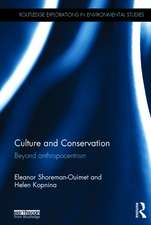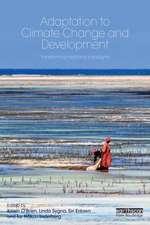Environmental Anthropology Today
Editat de Helen Kopnina, Eleanor Shoreman-Ouimeten Limba Engleză Paperback – 5 aug 2011
Environmental Anthropology Today combines a range of new ethnographic work with chapters exploring key theoretical and methodological issues, and draws on disciplines such as sociology and environmental science as well as anthropology to illuminate those issues. The case studies include work on North America, Europe, India, Africa, Asia, and South America, offering the reader a stimulating and thoughtful survey of the work currently being conducted in the field.
| Toate formatele și edițiile | Preț | Express |
|---|---|---|
| Paperback (1) | 422.04 lei 6-8 săpt. | |
| Taylor & Francis – 5 aug 2011 | 422.04 lei 6-8 săpt. | |
| Hardback (1) | 1006.30 lei 6-8 săpt. | |
| Taylor & Francis – 5 aug 2011 | 1006.30 lei 6-8 săpt. |
Preț: 422.04 lei
Nou
80.76€ • 84.32$ • 66.84£
Carte tipărită la comandă
Livrare economică 05-19 aprilie
Specificații
ISBN-10: 0415781566
Pagini: 320
Ilustrații: 8 tables
Dimensiuni: 156 x 234 x 18 mm
Greutate: 0.59 kg
Ediția:1
Editura: Taylor & Francis
Colecția Routledge
Locul publicării:Oxford, United Kingdom
Public țintă
Postgraduate and UndergraduateCuprins
Introduction: Environmental anthropology of yesterday and today (Eleanor Shoreman-Ouimet and Helen Kopnina) Part I: The Theoretical Perspectives 1. The Religion and Environment Interface: Spiritual Ecology in Ecological Anthropology (Leslie Sponsel) 2. Drawing from Traditional and "Indigenous" Socioecological Theories (Gene Anderson) 3. Environmental politics and policy ambiguities in environmental anthropology (Peter B. Larsen) Part II: Methodological Challenges 4. Environmental Anthropology as one of the spatial sciences (Emilio Moran) 5. What about that wrapper? Using consumption diaries in green education (Helen Kopnina) 6. Time and Population Vulnerability to Natural Hazards; The Pre-Katrina Primacy of Experience (Daniel de Vries) 7. Participatory Action Research and Urban Environmental Justice: The Pacoima CARE Project (Carl Maida) Part III: Anthropologists and the Real World 8. Anthropology, climate change and coastal planning (Bob Pokrant and Laura Stocker) 9. From Ecosystems Services to Unfulfilled Expectations, Factors Influencing attitudes toward the Madidi protected area (Teressa Trusty) 10. Who’s Got the Money Now?: Conservation-Development Meets the Nueva Ruralidad in Southern Mexico (Nora Haenn) 11. Middle-Out Conservation: The Role of Elites in Rural American Conservation (Eleanor Shoreman-Ouimet) 12. Learning By Heart: An Anthropological Perspective on Environmental Learning in Lijiang (Robert Efird) 13. Linking Climate Action to local Knowledge and Practice: A Case study of diverse Chicago neighborhoods (Jennifer Hirsch, Sarah Van Deusen Phillips, Edward Labenski, Christine Dunford, and Troy Peters)
Recenzii
- Riley E. Dunlap, Oklahoma State University, USA
Notă biografică
Helen Kopnina is based at the Institute for Advanced Labour Studies at the University of Amsterdam, The Netherlands. Her books include East to West Migration (Ashgate) and Crossing European Boundaries (Berghahn).
Eleanor Shoreman-Ouimet is a member of the Anthropology Department at the University of Connecticut, USA. Her research focuses on conservation, agriculture and environmentalism amongst rural communities.
Descriere
Today, we face some of the greatest environmental challenges in global history. Understanding the damage being done and the varied ethics and efforts contributing to its repair is of vital importance. This volume poses the question: What can increasing the emphasis on the environment in environmental anthropology, along with the science of its problems and the theoretical and methodological tools of anthropological practice, do to aid conservation efforts, policy initiatives, and our overall understanding of how to survive as citizens of the planet?
Environmental Anthropology Today combines a range of new ethnographic work with chapters exploring key theoretical and methodological issues, and draws on disciplines such as sociology and environmental science as well as anthropology to illuminate those issues. The case studies include work on North America, Europe, India, Africa, Asia, and South America, offering the reader a stimulating and thoughtful survey of the work currently being conducted in the field.


























